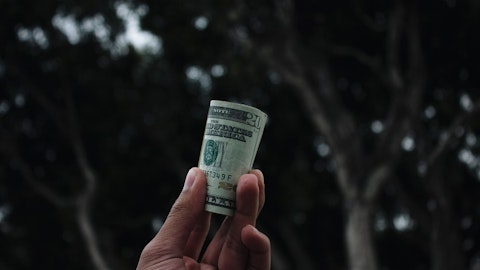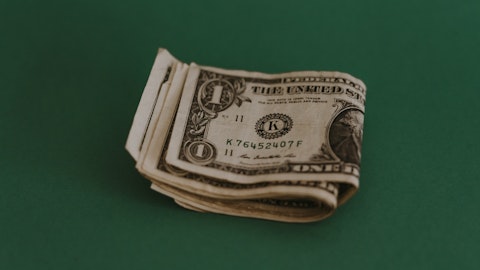Pentair plc (NYSE:PNR) Q1 2024 Earnings Call Transcript April 23, 2024
Pentair plc misses on earnings expectations. Reported EPS is $0.798 EPS, expectations were $0.9. Pentair plc isn’t one of the 30 most popular stocks among hedge funds at the end of the third quarter (see the details here).
Operator: Hello and welcome to the Pentair First Quarter 2024 Earnings Conference Call. All participants will be in listen-only mode. [Operator Instructions] After today’s presentation, there will be an opportunity to ask questions. [Operator Instructions] As a reminder, this conference is being recorded. I would now like to hand the call to Shelly Hubbard, Vice President, Investor Relations. Please go ahead.
Shelly Hubbard: Thank you, and welcome to Pentair’s first quarter 2024 earnings conference call. On the call with me are John Stauch, our President and Chief Executive Officer; and Bob Fishman, our Chief Financial Officer. On today’s call, we will provide details on our first quarter performance as outlined in this morning’s press release. On the Pentair investor relations website, you can find our earnings release and slide deck, which is intended to supplement our prepared remarks during today’s call and provide a reconciliation of differences between GAAP and non-GAAP financial measures that we will reference. The non-GAAP financial measures provided should not be considered as a substitute for or superior to the measures of financial performance prepared in accordance with GAAP.
They are included as additional clarifying items to aid investors in further understanding the company’s performance in addition to the impact these items and events have on the financial results. Before we begin, let me remind you that during our presentation today, we will make forward-looking statements, which are predictions, projections or other statements about future events. Listeners are cautioned that these statements are subject to certain risks and uncertainties, many of which are difficult to predict and generally beyond the control of Pentair. These risks and uncertainties can cause actual results to differ materially from our current expectations. We advise listeners to carefully review the risk factors in our most recent Form 10-K and Form 10-Q.
Following our prepared remarks, we will open the call up for questions. Please note that we will limit your questions to two, after which we ask you to reenter the queue in order to allow everyone an opportunity to ask questions. Note that we have now published our Pentair investor overview on our IR website, which includes the overview slides we previously included in our quarterly earnings presentations. Please visit our Pentair investor relations website and click on Events and Presentations to find this new overview. I will now turn the call over to John.
John Stauch: Thank you, Shelly, and good morning, everyone. First, I want to thank all of you who attended our 2024 Investor Day in New York last month. We appreciate your time and your insightful questions as we dove deeper into the business and provided our path to 24% ROS by full year 2026 with the potential for upside. Now, let’s begin with our strong Q1 results on slide four. The eighth consecutive quarter we continue to drive margin expansion. In Q1, ROS expanded 90 basis points despite sales being down slightly against peak channel inventory challenges in our residential segments. We exceeded our first quarter guidance as our Pentair teams drove solid execution across all three segments. In the first quarter, segment income and adjusted EPS also increased year-over-year.
Our transformation initiatives remained on track to deliver margin expansion, as we highlighted at our recent Investor Day. Approximately 50% of our total revenue is adopted and implemented value-based pricing as part of our strategic pricing initiatives. We are well into wave two of our sourcing initiatives, which we expect to begin to drive benefits in the second half of this year, and we have continued to drive operational footprint optimization and plan to continue this going forward. And we have recently introduced 80/20 training to 50% of Pentair’s revenue streams and have identified some quick wins and larger-term opportunities. Lastly, we are encouraged by signs that we are returning to a more normal operating environment for the first time in nearly four years.
Both our lead times and our backlog have been normalizing and our order rate trend has been in line with our expectations. As we expect to return to a more normal operating environment we have seen a mix of trends across our residential, commercial and industrial verticals within our three segments. For example, in Flow, commercial and industrial verticals performed well in Q1, while higher interest rates continue to impact residential and agricultural verticals. Within Water Solutions, our commercial businesses servicing the foodservice and hospitality verticals performed as expected. We believe residential will improve as year-over-year challenges moderate. Lastly, in Pool, a majority of our revenue is in the Sunbelt states, with a focus on higher-end in-ground pools.
In Q1, higher-end pools and the Sunbelt states remain resilient with the exception of California, where weather had a slight impact. From our recent dealer survey, remodeled pool projects appear to be increasing and services we surveyed were optimistic about the aftermarket. Let’s turn to slide six. Last week, we published our 2023 Corporate Responsibility Report with an update on our progress. At our Investor Day last month, our leader of ESG and Sustainability, Karla Robertson, provided a preview of our 2023 results on this slide. I’m very proud of the work Karla and our sustainability team are doing and the progress our teams throughout the company are making against our strategic targets. Before I turn it over to Bob, let’s turn to slide seven.

We delivered another quarter of quality earnings with better-than-expected results. Our Investor Day key themes remain on track. Our 80/20 training and workshops are underway with what we believe are promising early readouts and we are reiterating our full year 2024 outlook while introducing strong Q2 guidance with an adjusted EPS midpoint up 13% as compared to the same period last year. All-in, we continue to build a strong foundation to drive long-term growth and profitability across our diverse water portfolio. I will now pass the call over to Bob, who will discuss our performance and financial results in more detail. Bob?
Bob Fishman: Thank you, John, and good morning, everyone. Let’s start on slide eight. With sales over $1 billion, we delivered another strong quarter of quality earnings. Return on sales or ROS expanded 90 basis points despite sales being down 1% versus last year’s record Q1. Core sales were down 1% year-over-year, driven primarily by growth in Water Solutions, which was more than offset by slight decline in Flow and Pool. Sales across all three segments increased sequentially from Q4. Pool sales in Q1 exceeded Q4 2023 sales which in turn exceeded Q3 2023 sales as we had guided to last October. First quarter segment income increased 3% to $217 million and return on sales expanded 90 basis points year-over-year to 21.4%. These results were driven by favorable mix, price more than offsetting inflation as well as transformation.
ROS improved sequentially from Q4 and approached the Q2 2023 record of 21.6%. We delivered adjusted EPS of $0.94, which exceeded our guidance and was up 3% year-over-year. As John previously mentioned, we are excited to be entering what we believe to be a more normal operating environment for the first time in nearly four years. Please turn to slide nine. Flow sales declined 2% year-over-year. Commercial sales growth of 9% and industrial sales growth of 2% were more than offset by a decline in residential sales of 12%. Our residential sales are more closely tied to the overall housing and agriculture market. Segment income grew 19% and return on sales expanded 350 basis points to 20.1% marking the first time ROS has reached or exceeded 20%.
The strong margin expansion was a result of price and mix exceeding inflation and continued progress on our transformation initiatives. Please turn to slide 10. In Q1, Water Solution sales were up slightly to $273 million driven by commercial sales up approximately 1% and residential sales down approximately 1%. Segment income grew 6% to $56 million and return on sales expanded 110 basis points to 20.4%, driven primarily by favorable mix and transformation continuing to drive operational efficiencies. This is the eighth consecutive quarter of ROS expansion. Margins have nearly doubled from 10.8% in Q1 2022 to 20.4% in Q1 2024. Within our residential business in Water Solutions we have continued to see improvement in our year-over-year sales rate for the last five quarters.
Within our commercial business in Water Solutions, both filtration and ice drove sales growth, which was offset by lower services revenue due to project life cycles. Please turn to slide eleven. In Q1, Pool sales declined 1% to $359 million. However, Q1 sales improved nearly 7% sequentially from Q4 2023, as expected. Segment income was $111 million down 5%, and return on sales decreased 110 basis points due to lower volume an increase in costs as we prepared for the peak Pool season in Q2 and investment in transformation. We expect Pool margins to expand each quarter year-on-year for the remainder of 2024. Please turn to slide 12. At our Investor Day in March, we updated our three year margin targets to reflect margin expansion through full year 2026, extending our plan by a year.
With contributions from all four of our key transformation initiatives pricing, sourcing, operations, and organization we are targeting ROS to expand by 540 basis points to 24% as compared to full year 2022 and have the opportunity to do even better as we discussed during our Investor Day. In full year 2023, we achieved ROS of 20.8% and expect to continue to drive margin expansion to approximately 22% by year-end. Please turn to slide 13. This runway provides context of when we expect each wave to deliver margin expansion in our reported results. Note that we expect our transformation benefits to compound with each additional wave and the entire process to begin to repeat in 2027, creating a continuous cycle of ongoing savings. Please turn to slide 14.
In Q1, we used $127 million in cash, which is consistent with the prior year quarter. Q1 is predominantly a cash use quarter and typically followed by strong cash generation in Q2, our seasonally highest quarter. Our net debt leverage ratio was 2.1 times, down from 2.6 times in Q1 a year ago. Our ROIC was 14%. We continue to target high teens return on invested capital. We plan to remain disciplined with our capital and continue to focus on debt reduction amid the higher interest rate environment along with share repurchases to offset dilution. With the net debt leverage ratio within our target range, we have additional flexibility to strategically allocate additional capital to areas with the highest shareholder returns. Moving to slide 15.
For the full year, we are maintaining our adjusted EPS guidance range of $4.15 to $4.25 which is up roughly 12% at the midpoint. Also for the full year, we continue to expect sales to be up approximately 2% to 3% with Flow sales to be up approximately low single-digits, Water Solution sales to be approximately flat, and Pool sales to be approximately 7% for the full year. We also expect segment income to increase 8% to 11%. For the second quarter, we expect sales to be up approximately 1% to 2% compared to last year’s record Q2. We expect strong growth in Pool sales in Q2 somewhat offset by challenging compares in our Water Solutions segment. We expect second quarter segment income to increase 10% to 12% with significant ROS expansion. We are also introducing strong adjusted EPS guidance for the second quarter of approximately a $1.15 to $1.17 up roughly 13% at the midpoint.
I would now like to turn the call over to the operator for Q&A after which John will have a few closing remarks. Operator, please open the line for questions. Thank you.
See also Latest Insider Trading Activity: 11 Stocks Executives and Directors are Buying and 14 Dividend Growth Stocks with Highest Growth Rates.
Q&A Session
Follow Pentair Plc (NYSE:PNR)
Follow Pentair Plc (NYSE:PNR)
Operator: Thank you. We will now begin the question-and-answer session [Operator Instructions] Today’s first question comes from Mike Halloran with Baird. Please go ahead.
Michael Halloran: Good morning, everyone. Thanks for the question. So two questions here. First one just how are you thinking about the end markets as you work through the rest of the year? I mean the overall topline guidance is really unchanged. So I guess the question is, are you seeing anything different today than you were thinking a few months back? And how are you thinking about the sequentials from here across your end markets?
John Stauch: So far, Mike, I would say things are playing out exactly like we thought and hoped for with the exception of maybe within our Flow segment, the Residential side and the Ag-side being a little weaker as we progress through the end of the year. Other than that, everything is generally in line with our previous expectations.
Michael Halloran: Thanks for that. And then on the Flow margins, awfully impressive and certainly seems a little different than I would have expected seasonally. So maybe some thoughts on how you think those margins sequentially work from here, in particular, anything in the first quarter that’s not repeatable from a mix perspective or anything else? And is this just an example of the right foundation to build ROS with all the work you guys are doing internally?
Bob Fishman: It really is. On the Flow side, we were extremely pleased with the ROS expansion in Q1. And again, we’ve said that they will be one of the main beneficiaries of the transformation program. So I expect the segment to continue to expand their ROS year-on-year because a lot of the play there is around strategic sourcing, the pricing excellence, the operational footprint, and basically the complexity reduction play.
Operator: Thank you. The next question comes from Brian Lee with Goldman Sachs. Please go ahead.
Brian Lee: Hey guys. Good morning. Kudos on the solid execution here.
John Stauch: Thank you
Brian Lee: I guess maybe as a follow-up to Mike’s question. I mean, I think the most eye-catching metric was definitely the ROS and Flow, looks like both price cost and transformation benefits were driving a lot of this. I know it’s a little bit lumpy if we look historically, but what is kind of the right run rate to think of in this segment coming off this 20% result in Q1? How much more, I guess, price cost or transformation or anything else you want to outline as we think about year-on-year improvements in ROS, just particularly for Flow?
John Stauch: Yes. I mean just to reiterate what Bob said, I think we’ve done a nice job of refocusing the business and driving transformation. One thing that really kind of helps is, if you think about Flow. There is a business inside of Flow. It’s our sustainable gas business, which last year had several larger losing projects, and we’ve been able to right-size that business and bring those project executions back up to, let’s call it, low single-digit margins. But we are getting a very favorable year-over-year comparison against those performance last year. So we do think this is a good starting point. And as we move through the year, we’re going to continue to manage the mix and drive the transformation programs and really pleased with the Flow performance.
Brian Lee: Okay. Great. Helpful. And then second question, just when I look at Pool, again, I know quarter-to-quarter, this can kind of fluctuate, but productivity sort of reversed in Q1, 200 basis point headwind versus the tailwind. You saw last quarter, which was about the same 200 basis points. Is this all investment? Can you kind of break down or quantify how much it was this quarter? It seems like it might have been a big send quarter and should we expect this drag for a few more quarters or does ROS go right back up positive year-on-year? I know you’re saying growth is sequentially better throughout the year. How about, I guess, margins in ROS, in Pool specifically, as we think about the cadence? Thanks guys.
Bob Fishman: Yes. In my prepared remarks, I did mention that ROS and Pool will increase year-on-year for the balance of the year. So comfortable that we’ll see ROS expansion within the Pool business. I think Q1 was a little bit unusual and that the volume was declining, but we have significant growth in Q2. And so some of the costs, the ramp-up of cost to service the strong Q2, obviously put a damper on the margins in the first quarter. We also are continuing to invest to drive growth and transformation wasn’t where we needed it to be within the Pool business. But those investments will pay off and further ROS expansion down the road. So again, comfortable with the ROS expansion in Pool, the remainder of the year. And again, as we ramp to significant growth in Q2, that will become a big manufacturing leverage play as well.
Operator: Thank you. The next question comes from Damian Karas with UBS. Please go ahead.
Damian Karas: Hi. Good morning everyone.
John Stauch: Good morning.
Damian Karas: My first question is on the Pool business. You had mentioned in your slide that remodel inquiries are up. Could you give us a sense for how much are we talking here? Is that kind of across the board or was that also just like on the high-end side of the market? And is your expectation for remodels still kind of down low-single-digits for the year in your guidance?
John Stauch: Yes, to the second one. But we do feel there’s some encouraging trends that will give us feeling that our dealers will start to take more orders, which would extend into ’25 and ’26. I think with all the new Pools being built, there probably wasn’t as much attention being spent to getting the remodel sequenced and completed. And I think we’re encouraged that we’re now seeing that part of the market get some demand from our customers and again, this is primarily in the key Sunbelt states and more on aged Pools.
Damian Karas: Okay. That’s encouraging to hear. And then could you just help us think about the Water Solutions and that 9% comp year-over-year. How are you thinking about the second quarter for the segment kind of both in terms of top line and segment margin?
Bob Fishman: From a top line perspective, it’s important to remind everyone what a large quarter Q2 was last year, especially within the Ice business. So we do see a decline year-on-year within Water Solutions as they bump up against that tough compare. So think of the Ice business and services having a bit of a headwind and then the filtration business continuing to grow nicely.
Operator: Thank you. The next question is from Andy Kaplowitz with Citigroup. Please go ahead.
Andrew Kaplowitz: Hey, guys. How are you?
John Stauch: Good. How are you?
Andrew Kaplowitz: Good. John and Bob, just maybe following up on Water Solutions. Look [indiscernible] guys hanging in there a little bit more than you would have thought. Obviously, comps are tough as you just talked about. I think your guidance for commercial water was up low-single-digits for this year. Is that still what it is? And then what happened in services? And would you expect that to sort of come back as the year goes up?
John Stauch: Yes, on Ice. I think Ice is going to play out right now the way we expected it to. And as a reminder, as Bob said, tough compare in Q2. But overall, I think it’s going to come in line with our expectation. And still has resilience in the end industry, and we’re feeling good about our filtration penetration, combined with that BU to drive it. We are going to dial our services business into more profitable annuity-based services as we exited some of the larger programs that we were doing with some of the large fast food companies and some of those were not very profitable, and we want to refocus the business into a simpler mix of service, more geared to the products that we install and so we will see that be a little lumpy throughout the year as well.
Andrew Kaplowitz: It’s helpful guys. And then, Bob, are you still thinking $75 million in productivity this year even with the slower start in Pool and the $4 million in total in productivity for Q1?
Bob Fishman: Yes. Again, we were pleased with the transformation readout in Flow and Water Solutions, but it was offset somewhat by the negative productivity and Pool as we ramp up for Q2, still feeling very comfortable with the $75 million number and think of that as being fairly linear over the next three quarters.
Andrew Kaplowitz: Thanks.
Operator: Thank you. The next question is from Steve Tusa with JPMorgan. Please go ahead.
Steve Tusa: Hey, guys. Good morning.
John Stauch: Good morning Steve.
Bob Fishman: Hi, Steve.
Steve Tusa: Just a follow up to that bridge question for the year. Can you just update us on what you’re thinking on price and then just the spread on price cost and price and inflation for the year?
John Stauch: Yes, I think we’re still hopeful we can get price to offset cost. I mean we did see a little incremental inflation start to enter Q1 into Q2. I think it’s primarily around what we’d call freight and probably specifically copper. So we’re monitoring that, Steve. If needed, we would go back out and see what we could recover from a price standpoint. And our goal is to, for the full year, try to offset price and cost.
Steve Tusa: Okay. And 2%-ish price for the year. Is that still kind of in there or — what you did 3% in the first quarter?
John Stauch: Yes. We’re still in that 2% for price and think about 3% inflation on the cost base. Those two would roughly offset from a dollar perspective.
Operator: Thank you. The next question comes from Bryan Blair with Oppenheimer. Please go ahead.
Bryan Blair: Thanks. Good morning, everyone. Solid start.
John Stauch: Good morning.
Bryan Blair: A quick follow-up on productivity and transformation read-through. You said step up somewhat ratable for the next three quarters to get to the $75 million. Given the moving parts of Q1 and divergence in segment contribution, how should we think about how that drop-through shakes out for the segments going forward?
John Stauch: We expect Pool to have a very significant contribution in Q2 given its rate of growth and the fact that we, as Bob mentioned, we had some incremental investments to get the product prepared to ship in Q2. And so think about that as labor being roughly flat from Q1 to Q2, but getting a lot more revenue in Q2. So that would be a huge contribution. Corporate is always a timing issue. Also, Bob didn’t mention that, but we have higher corporate expenses that run in Q1 typical in the industry and so that usually comes down as it heads into Q2 as well. But I think the rate of contribution will be the same for the other segments and then we get the step-up in Pool.
Bryan Blair: Yes. I appreciate the detail. And I understand that debt reduction is the priority near term with regard to capital deployment. Although with your second quarter cash flow, suspect by June, July timeframe, you’ll be under two times levered. Any color you can offer on your M&A pipeline and whether we may see any deal for the second half of this year, it’s better to anticipate you get back to that growth lever in more 2025 timeframe?
Bob Fishman: I agree with the comment that the cash flow is providing strong optionality for us. What was interesting is we started the year thinking there would be three rate cuts. We’ve now built into our guidance of $100 million of interest expense, no rate cuts. So we think that’s prudent. We were able to keep the interest expense the same as our previous guide, primarily because the free cash flow is happening earlier in the year. So we look forward to a strong Q2 in free cash flow. To your point, we’re right within our target range. We think there continues to be a debt reduction play to help the EPS. We’ll restart the share repurchases to offset dilution and then there remains optionality in terms of what drives the highest shareholder value.
Operator: Thank you. The next question is from Julian Mitchell with Barclays. Please go ahead.
Julian Mitchell: Hi. Good morning. Maybe just wanted to put a finer point on that second quarter sales guide. So in total, it’s up one to two points year-on-year. Based on your comments, Bob, is it right to think about Waters may be down mid-single digits, Flow is flattish and then you’ve got Pool up 10% plus. Is that the right sort of framework for Q2 sales?
Bob Fishman: I would agree with those numbers, Julian.
Julian Mitchell: That’s very helpful. Thank you. And then just my second question would really be around sort of the inventory situation. I think your own inventories are flattish sequentially in March, down a lot year-on-year. Maybe help us understand kind of how you’re assessing inventories on the customer and channel partner level? And how do you assess your own sort of inventory rate versus kind of history for where we are in the year?
Bob Fishman: From our perspective, inventory from a days on hand is still significantly higher. We go back to 2019 and see each of the segments has room for improvement. That being said, year-on-year, we were down roughly 10 days from an inventory on hand perspective. So we’re moving in the right direction. To bring down those inventories, the volume will certainly help in the second quarter, but we’re not quite where we want it to be.
John Stauch: And then on the channel side, I think we’re at normal levels. I think right now, we’re working with our channel partners, and we’re generally shipping through in the same quarter with being bought. So I feel like all that’s behind us here in the Q2.
Operator: Thank you. The next question comes from Jeff Hammond with KeyBanc Capital Markets. Please go ahead.
Jeffrey Hammond: Hey, good morning guys.
Bob Fishman: Hey, Jeff.
John Stauch: Hi, Jeff.
Jeffrey Hammond: Just on Pool, I mean, John, you seem a little more confident in how things are shaping up, at least from the survey work. And I think you talked about kind of having these added costs to ramp. And so just wondering what it takes for you guys to kind of lift expectations there? And then just also any early read on the start of the Pool season here, I know weather was pretty disruptive last year.
John Stauch: Yes, Jeff, I appreciate the question. I mean just — as a reminder, I mean, Pool markets are — and sell-through on a normal market basis still be down mid-single-digits. So we’re benefiting from those year-over-year easier compares as we ramp up and no longer have those inventory headwinds. And then I feel like we’ve got better insights and into the sell-throughs and the way that we now can work to get those shipments out in five days, where we’re tying the shipments to the sell-through. So, yes, it does feel better and it feels like more normal, which is why we use the word normalized for a period of time. So I feel good about that. Interest rates are going to be pesky. And I think it’s affecting the financing.
It’s affecting dealer financing and the sense of where they’re getting their working capital loans from, it is going to continue to challenge the industry. And also, when interest rates are like this, we don’t see movement from people selling their house and buying another house, which are what our business tends to like, the water doesn’t taste the same and then you invest in a water filtration system. So Jeff, we could use those lower interest rates at some point to send a signal that things are going to be brighter. And I think that, that’s what we’re reflecting in the — in our current hold of the full year forecast. And then we feel confident we have transformation and we have cost out initiatives to make up the gaps if we continue to see this be challenged as we head through the back half of the year.





